Individual Tutorial Notes with CJ - Week 4
I talked about how I wanted to focus more on the textile aspect of my work, creating bigger textile pieces and smaller ceramic pieces as knitting is an important and enjoyable aspect of my work.
My knitting tends to put me in a state of flow – I should investigate the work of Mihaly Csikszentmihalyi. Could my work show the notion of time? Could ceramics be used as the marker of time as well as the textile?
The work of Richard McVetis shows this, and I will investigate his work.
When being ill I found that the only thing I could do was knit, being productive even though it didn’t feel like it. Could I use the activities I do alongside knitting, for example, watching TV, listening to music/podcasts to mark my work?
I will create a diary or record of my knitting. What words will come up? Can I focus my thoughts on something else instead of forcing the thoughts that I expect to have?
Respond my knitting to my surroundings and experiment with narratives as well as different stitches/fibres/needles.
Make sure there is a reason for the ceramics and think about how I could bring colour into it. Is there a value held within certain colours?
Leading on from the above feedback from CJ, I responded to my surroundings through machine knitting. Creating different pieces where I responded to thoughts and sound. Due to some challenges with tension, it wasn't until the last piece that i found myself really getting into the state of flow. The first knitted sample was me creating a pattern of lace holes, I would shift each hole 1 stitch to the left or the right depending on how confident I was feeling with my machine knitting. I found that this created a curved patterns of lines across the work and I liked it. The second piece was me creating lace holes when there was a change in sound around me. Creating a couple of holes based on where I was when knitting a shape using partial knitting. Doing two things at once (partial knitting and lace holes) did end up in me feeling confused and with the added issue of a loose knitting tension, the knitting machine ended up being very stiff and it ended up being difficult. The third sample ended up being my favourite to knit, creating lace holes based on sounds I was hearing. The closer the sound in either ear, the closest to the middle it would get. Based off of sounds that were far away, close, hearing from the left or right. I created a pattern of holes based on what I was hearing in a public space in the moment.
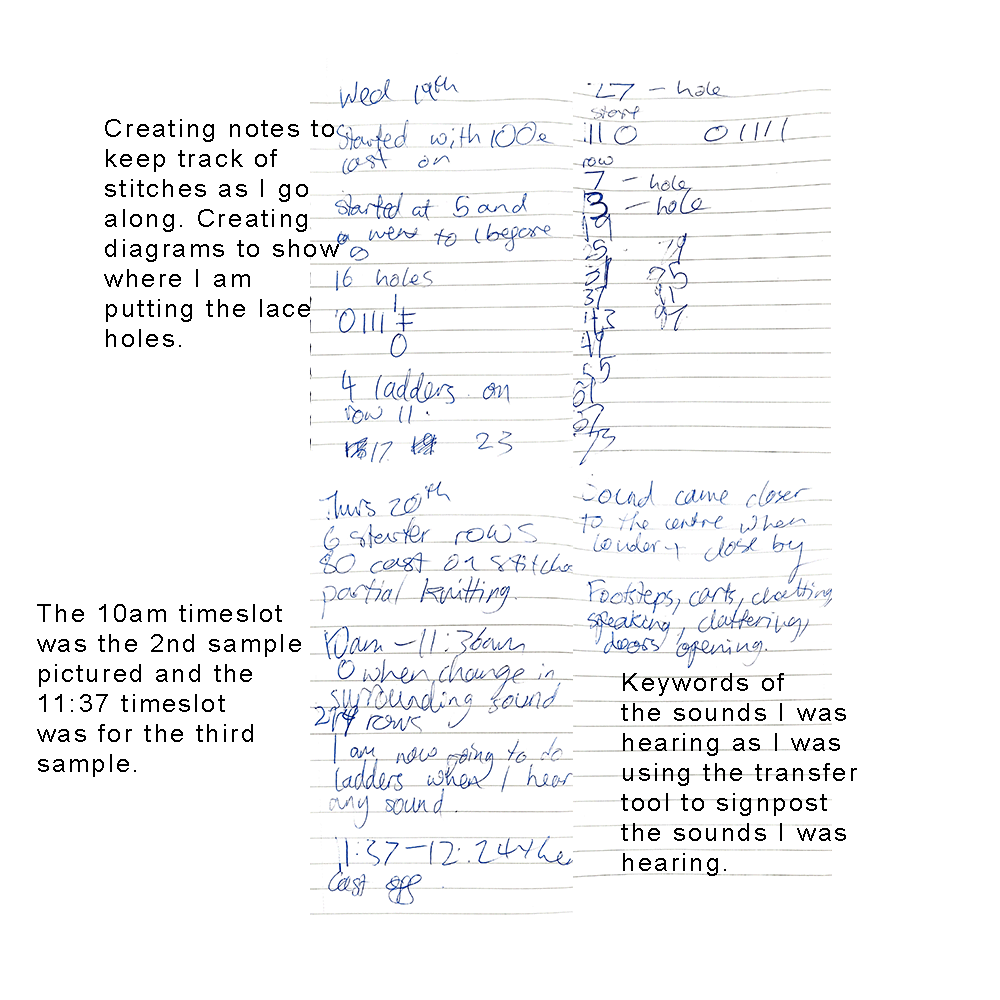
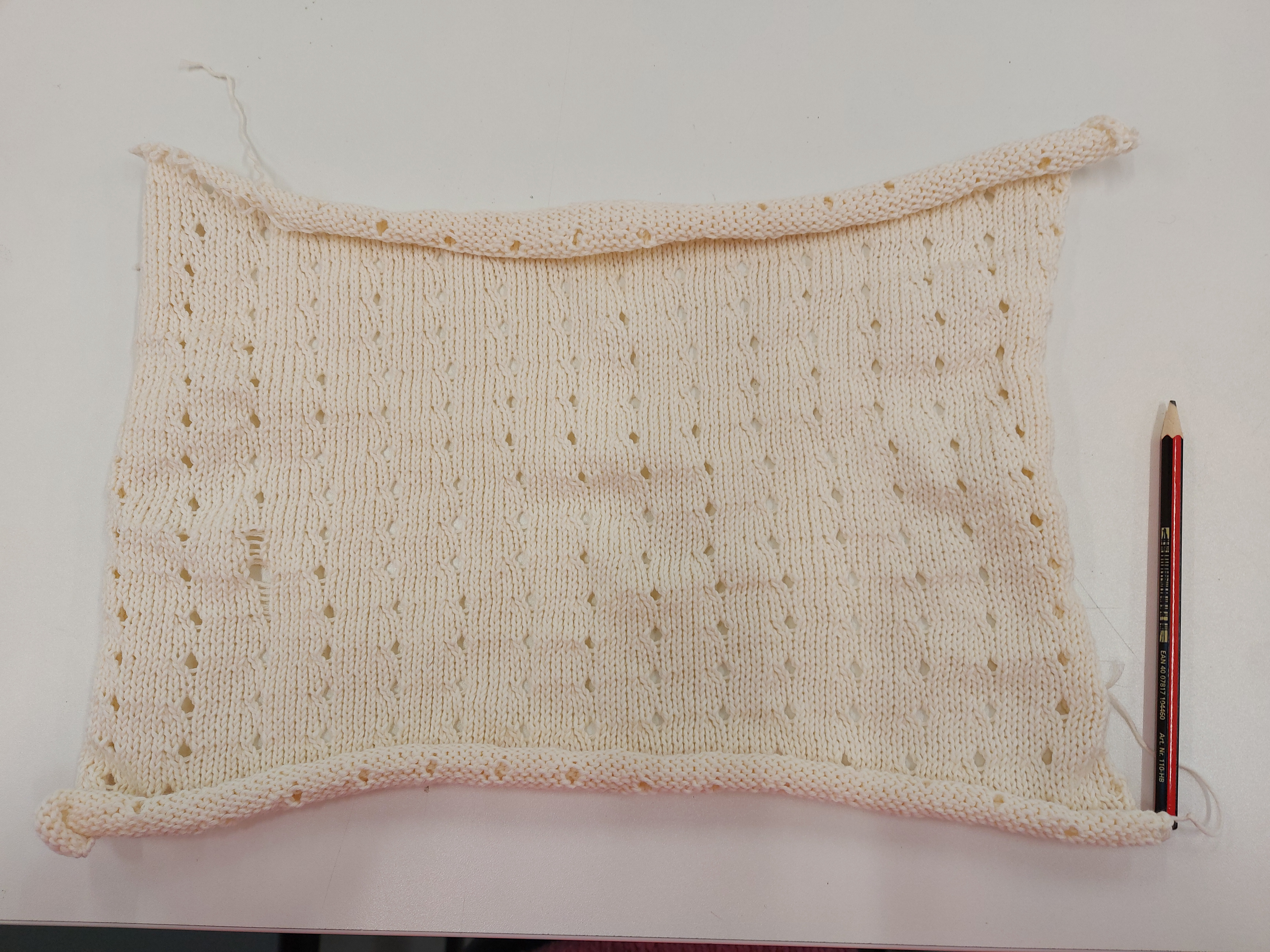
1st Knit Comfort Scale
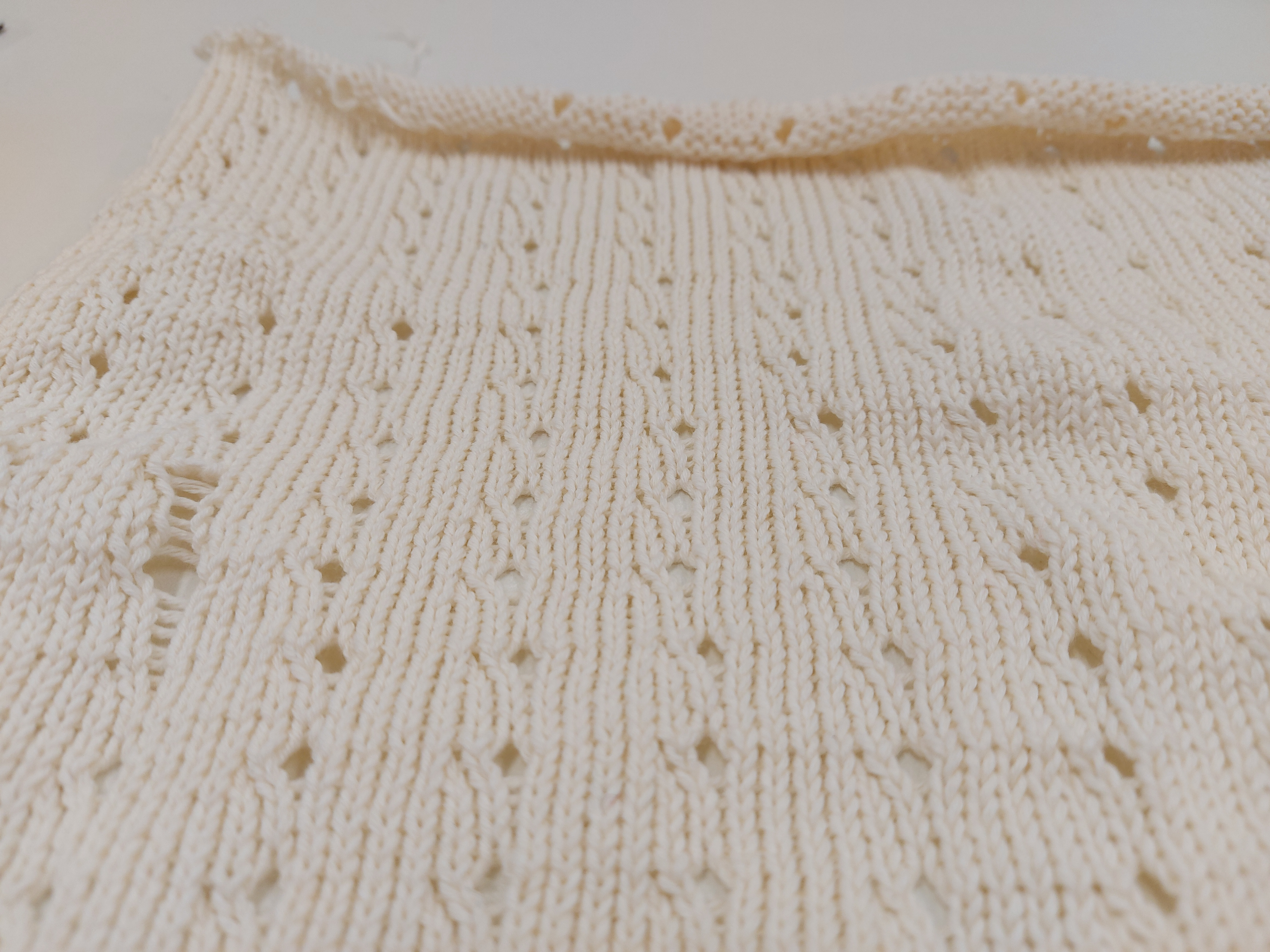
1st Knit - Comfort Scale

2nd Knit - Partial Knitting
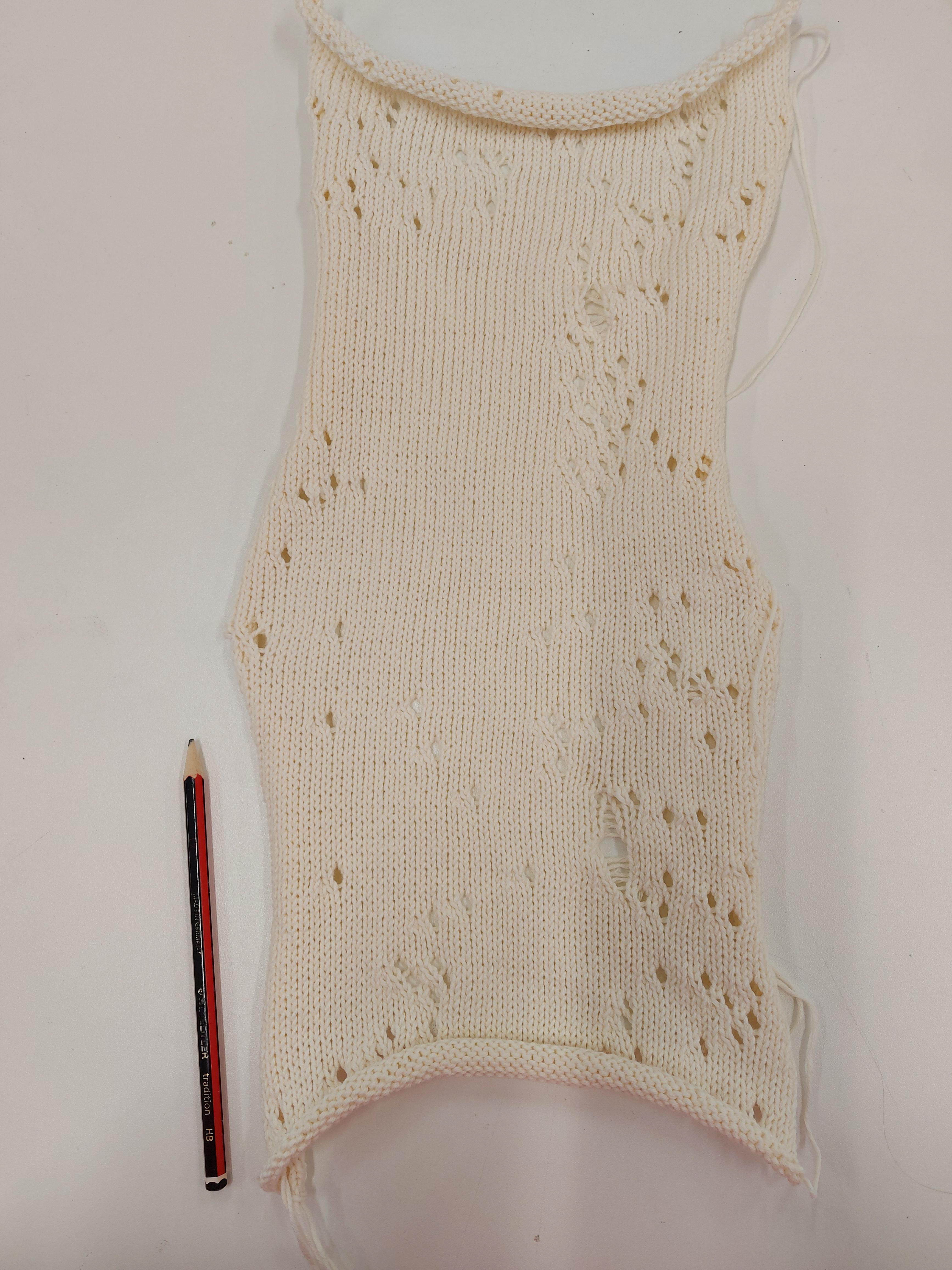
3rd Knit - Sound Scale
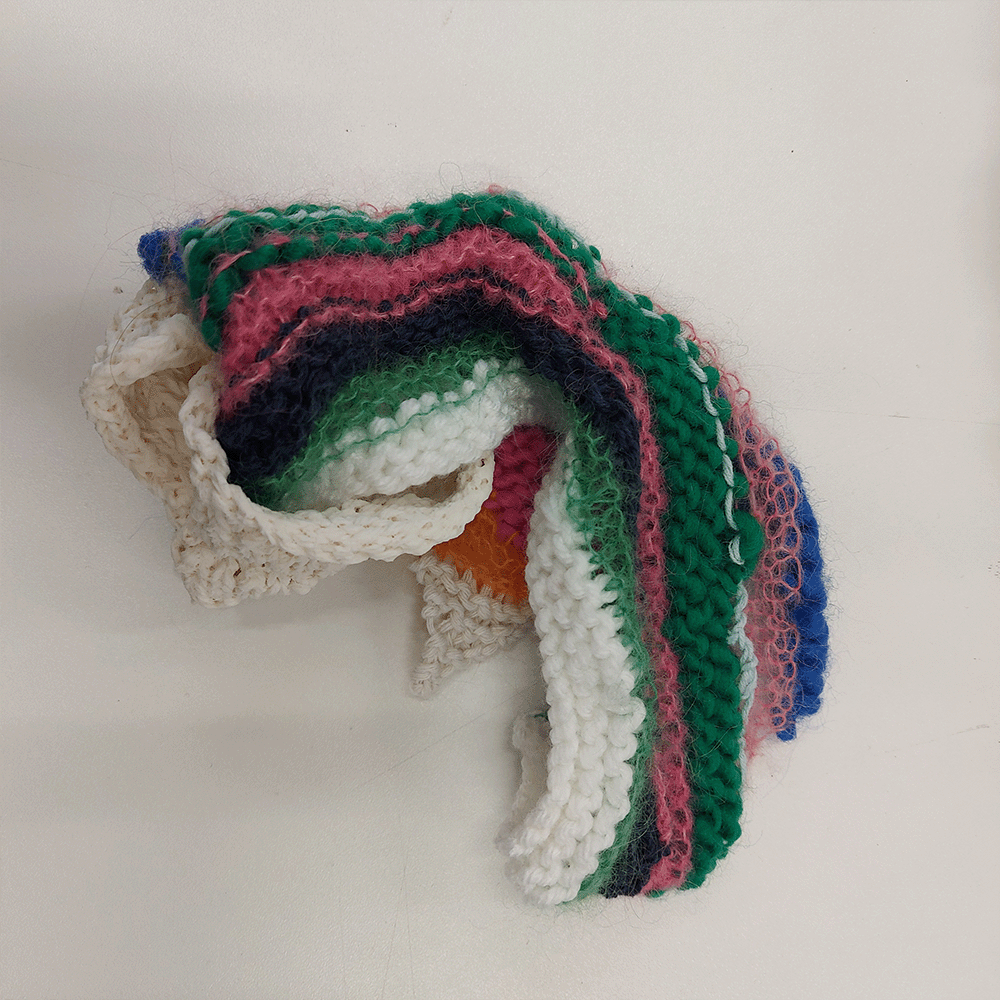
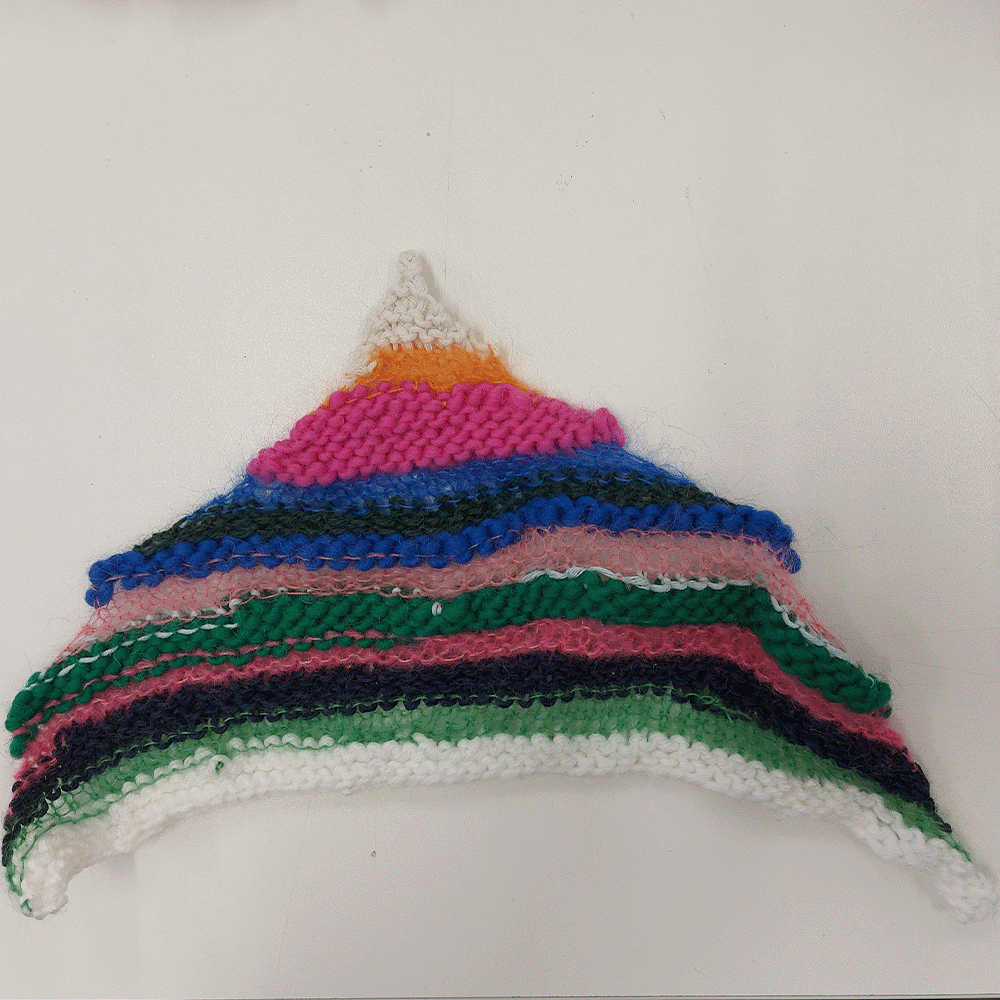

I spent Sunday afternoon knitting alongside two episodes of a television show, whenever the mood shifted within the show or I felt like the episode changed I switched the yarn. This was a mix of me knitting according to my surroundings, but also being inspired by television, which I tend to watch when I usually knit. This doesn't normally inspire the knitting I do but because this is normally in the background when I normally knit. I also used a small ceramic piece to pull through the knitted object. These yarn changes came at times where I felt best compared to a point that is explicitly clear. I am going to try and use a more defined subject to base my knitting off, for example, time or breaks.
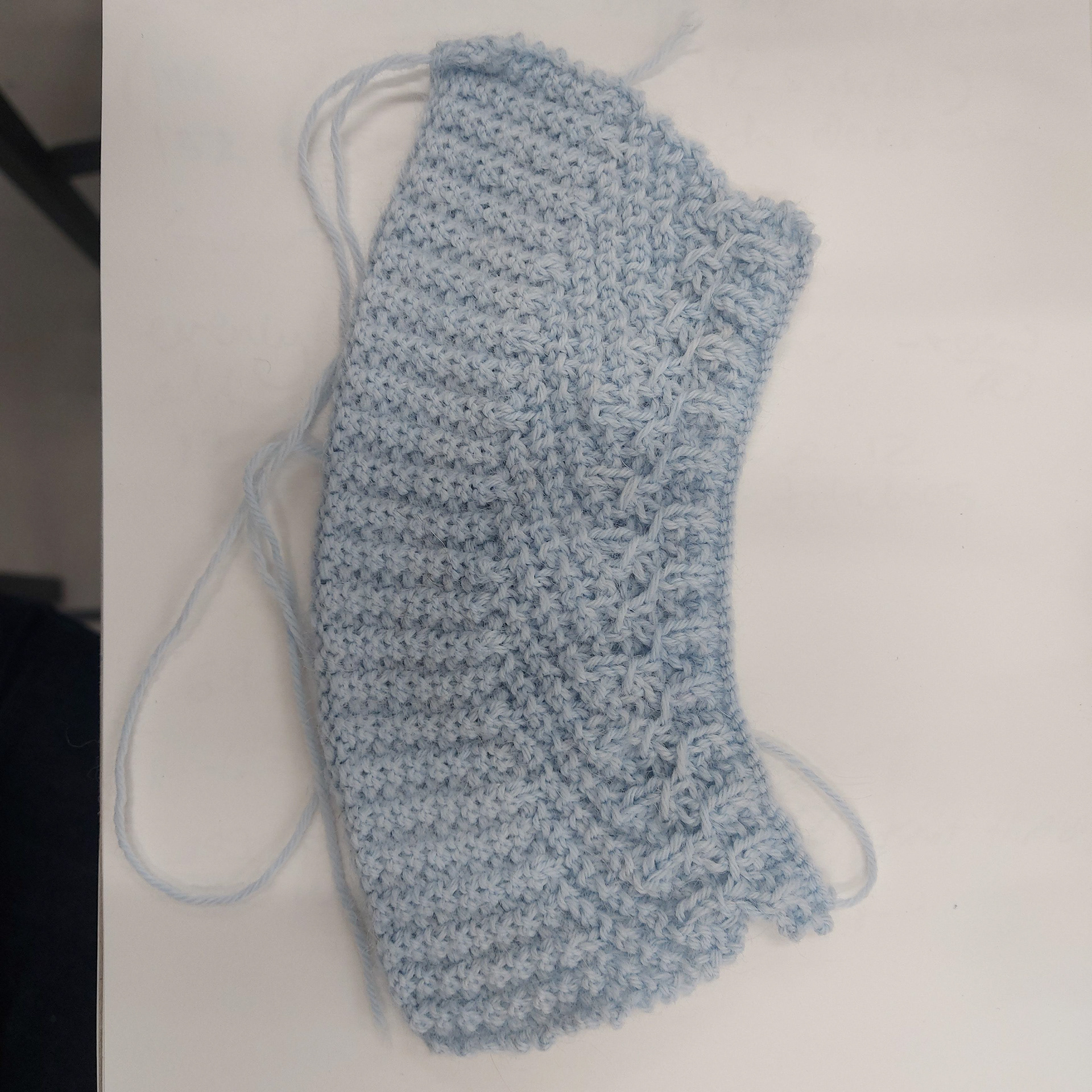
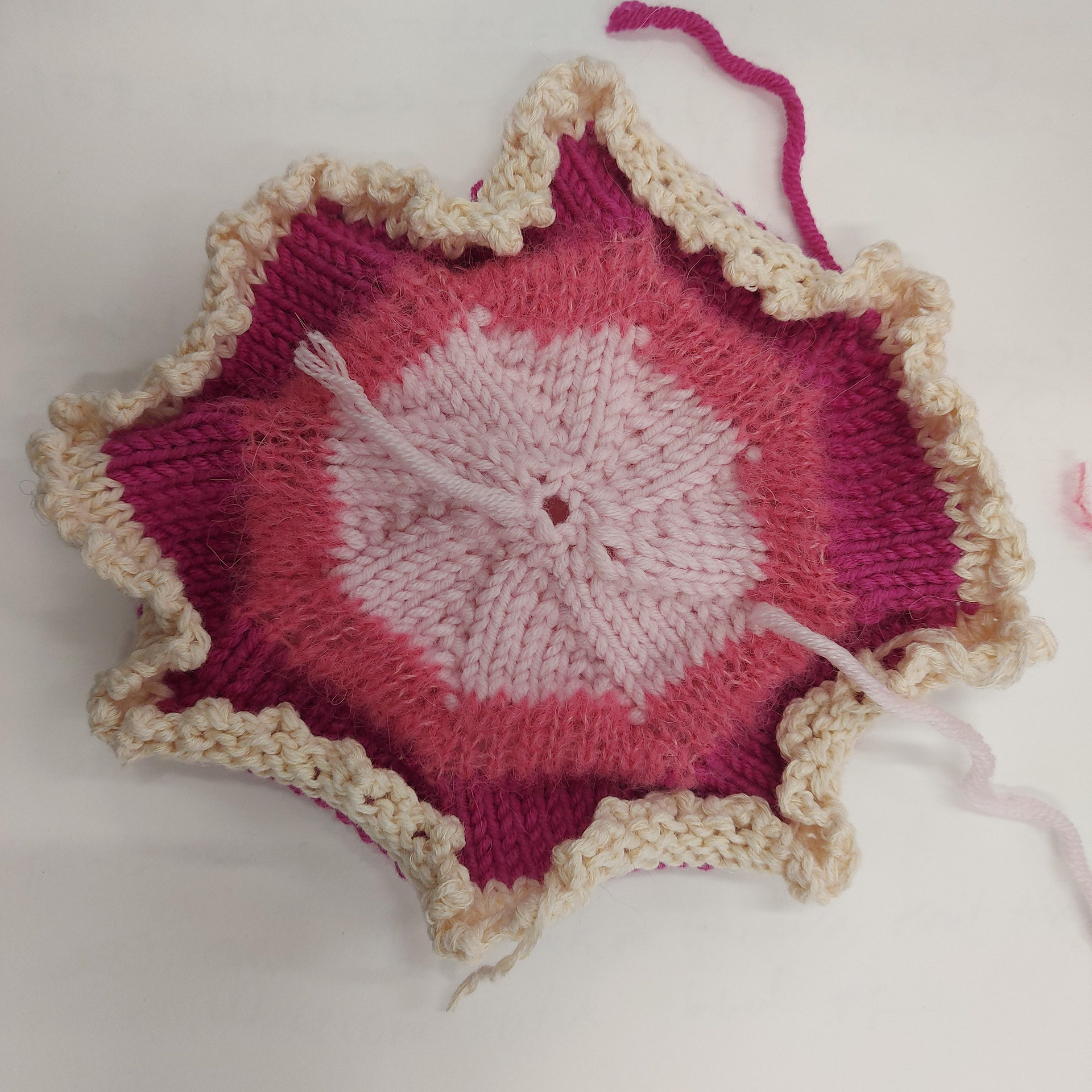
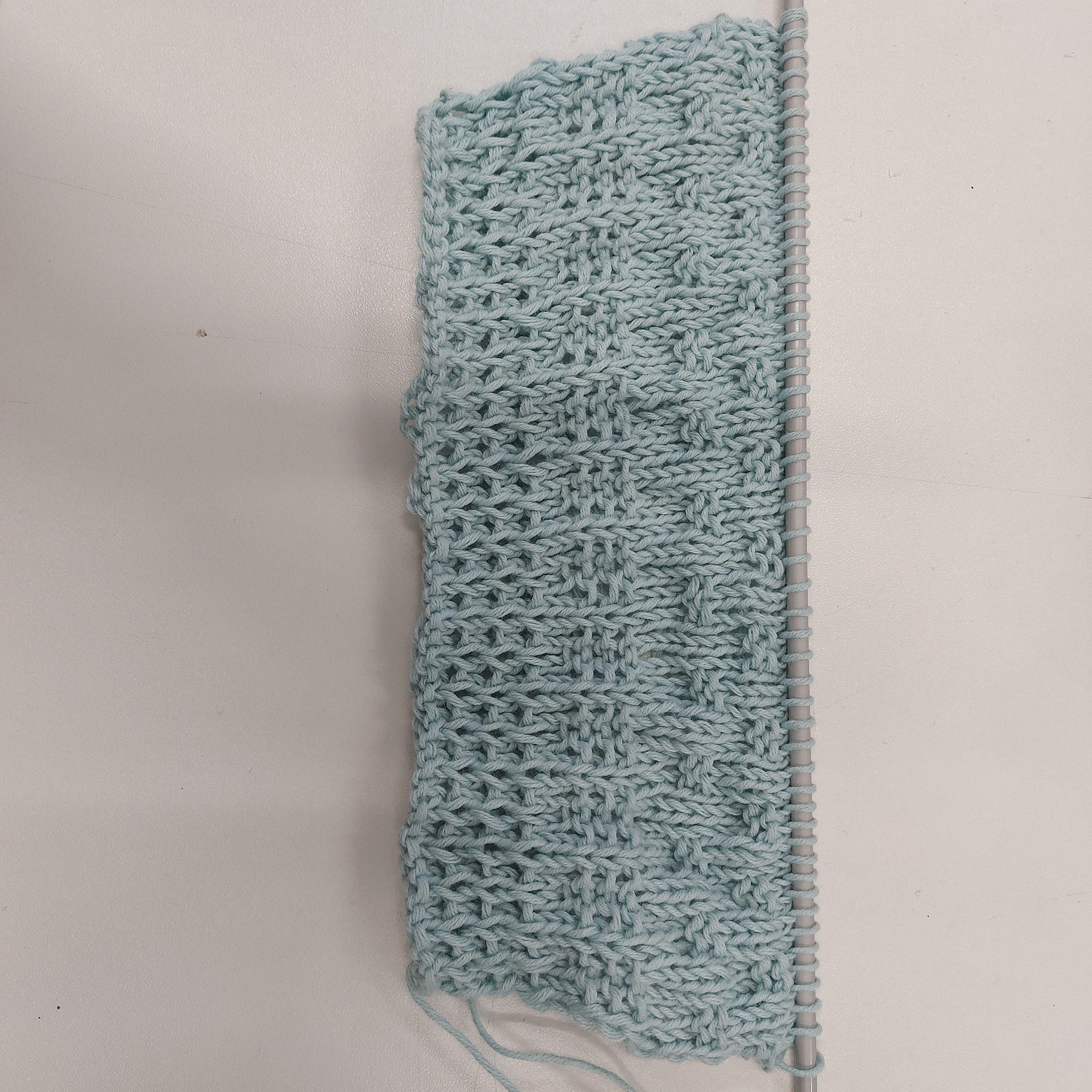
I knitted some samples reacting to my surroundings in different ways. The first piece was me on the train, seeing how each stitch could feed into each other. The second piece was me working within a circular pattern, gradually getting a darker pink as I proceeded throughout the day. I also wanted to knit with a decorative cast off to see how this would show up and if this could be a way of making the work more interesting to look at. The third piece was made using the same yarn I had been using on the knitting machine, the mix of the more square looking stitches was to show me going and away and coming back to this knitted piece over the course of a few days. It was also interesting to see how the stitches could also fuse into each other by using similar stitches. Overall time was a way of seeing my surroundings and the act of knitting over different times, normally in one place or a couple. I liked the mix of different stitches but the visuals of the knitting may be quite confusing to the viewer.

The slips mixed with water

100% 80%

60% 40%
I used water to thin my porcelain slip down to thinner consistencies, using a syringe to measure the slip to water ratio precisely. I then put the cotton lace hole shapes into the different slips, as lace knitting has been an issue to knit in the past, I wanted to see how the knitting fares differently with the slip. I could already see how the slip effects the knitting more, with the 100% slip getting thick and claggy, with the weight stretching out the knitting, while the higher the water percentage, the less the knitting becomes warped. Because the thinner slips (60% and 40%) don't look like they've absorbed into the knit as much as the 80%, I'm intrigued to see how they look once they're out of the kiln. I'm not sure if the slip will survive due to it being so thin.
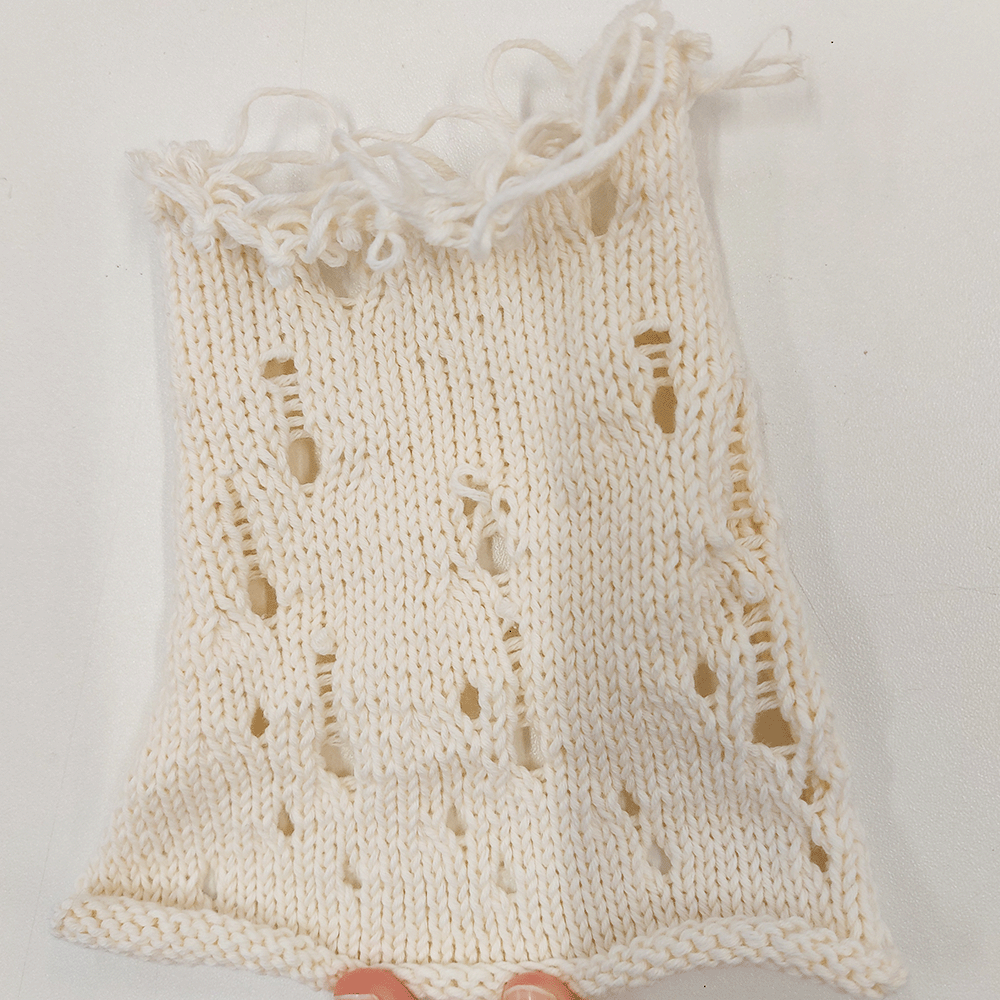
I experimented with different ways of making holes on the knitting machine. I found that some turn into ladders when I try to make bigger holes and I also tried using a three needle transfer tool which I hadn't used before and found that the hole looked slightly more pronounced than the other two using a 1 needle and two needle transfer tool. I will use the three needle transfer tool to create two holes next to each other when creating a knitted piece that is going to be weighed down by the ceramics.

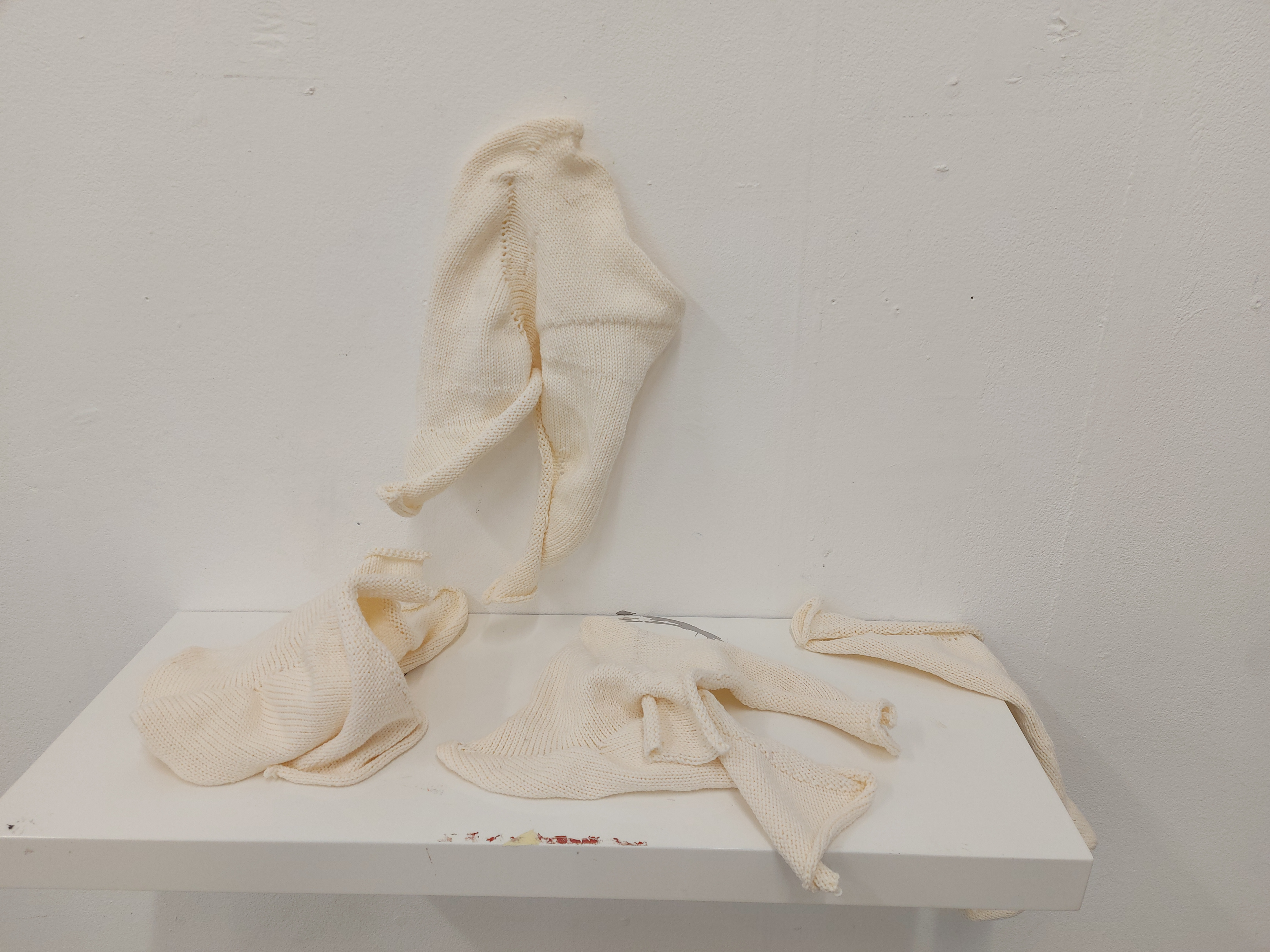
Experimenting with the ledge and how I could present the repeated shapes in different ways, I started looking at how the different shapes could be presented, flat , sat upright, hung up vertically or horizontally.
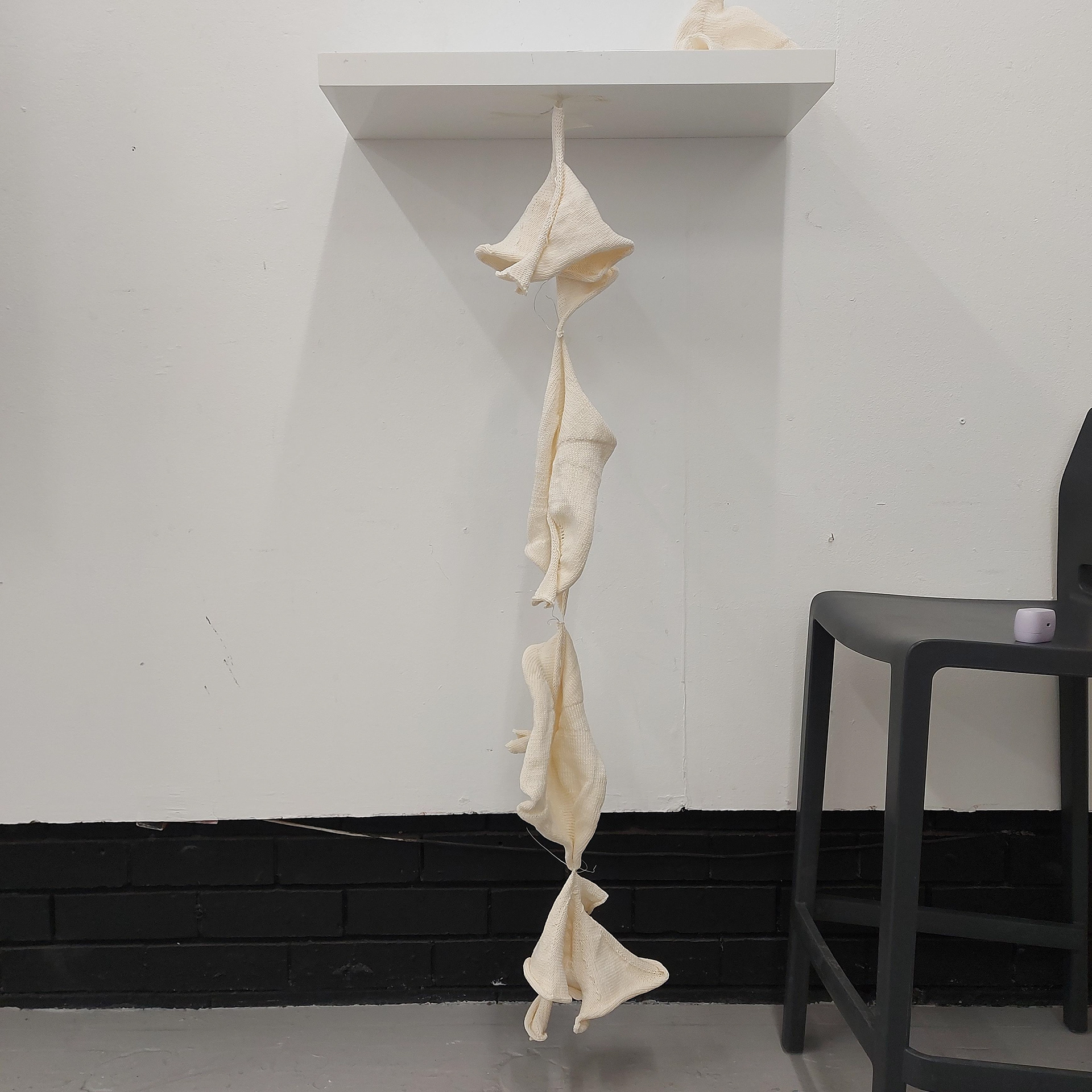

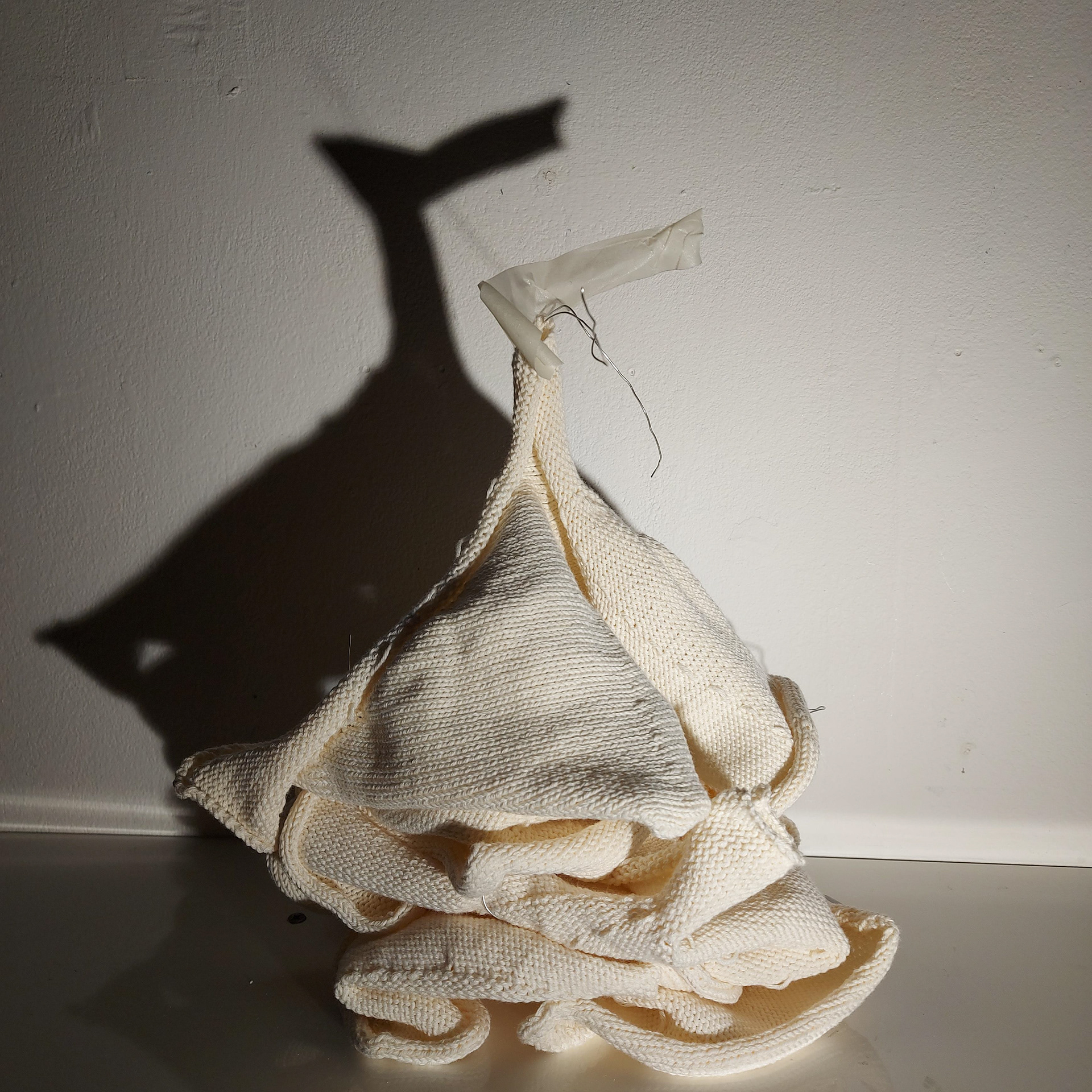
I hung up the repeated shapes from a different part of the shape each time, ensuring that it would look different each time. I also used light to see how the shadows look against the wall, seeing that as the light moved the angle of the shadows could be seen at different points. The movement of the hanging knitted shapes were slight but also affected the way you saw the knitting, seeing more than the shapes flat vertically against a wall. The shapes that are put on top of each other could be another way of showing the presentation of a repeated shape, doing two pieces where one of the shapes are almost exploded against the wall and another where the shapes are scrunched together and shown as one shape.
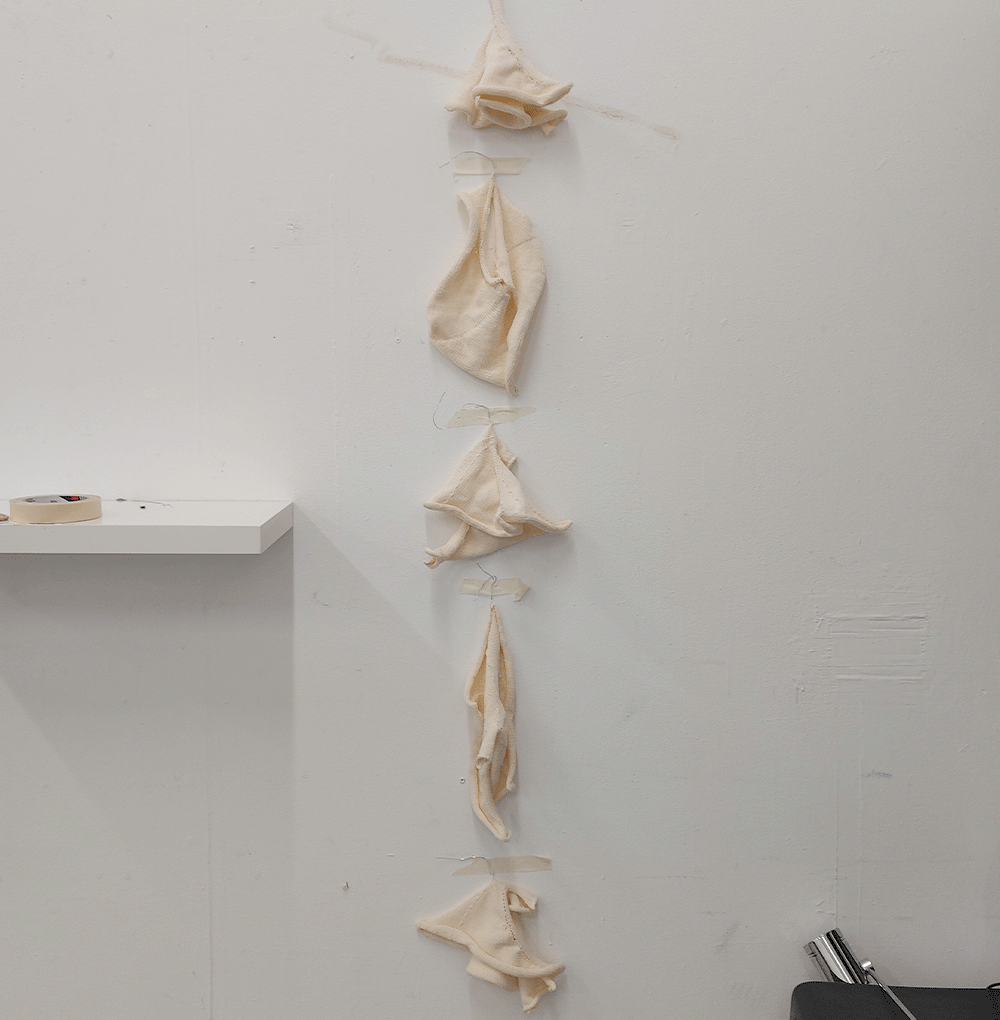


I hung the shapes flat against the wall, letting them hang organically but pinning them against the wall at one point each. Looking at them vertically means that you are going to see them from a different angle individually and this could be something that I think about when I curate my repeated shapes. Could I lhave them viewed from above? or from below? or from the side? I found that having the light on them gave shadows that looked completely different each time and the 3D effect of them hanging against the wall but not completely flat meant that the shadows were more pronounced.
Seeing the work horizontally shown in a line does mean you see them all together and you are more likely to analyse the differences and similarities better than if presented vertically. The shapes are hanging from different angles so the shapes look different but are slightly turned as you go along. This means that the shapes at either end are hung at angles that are hung from each end and are almost the opposite of each other.
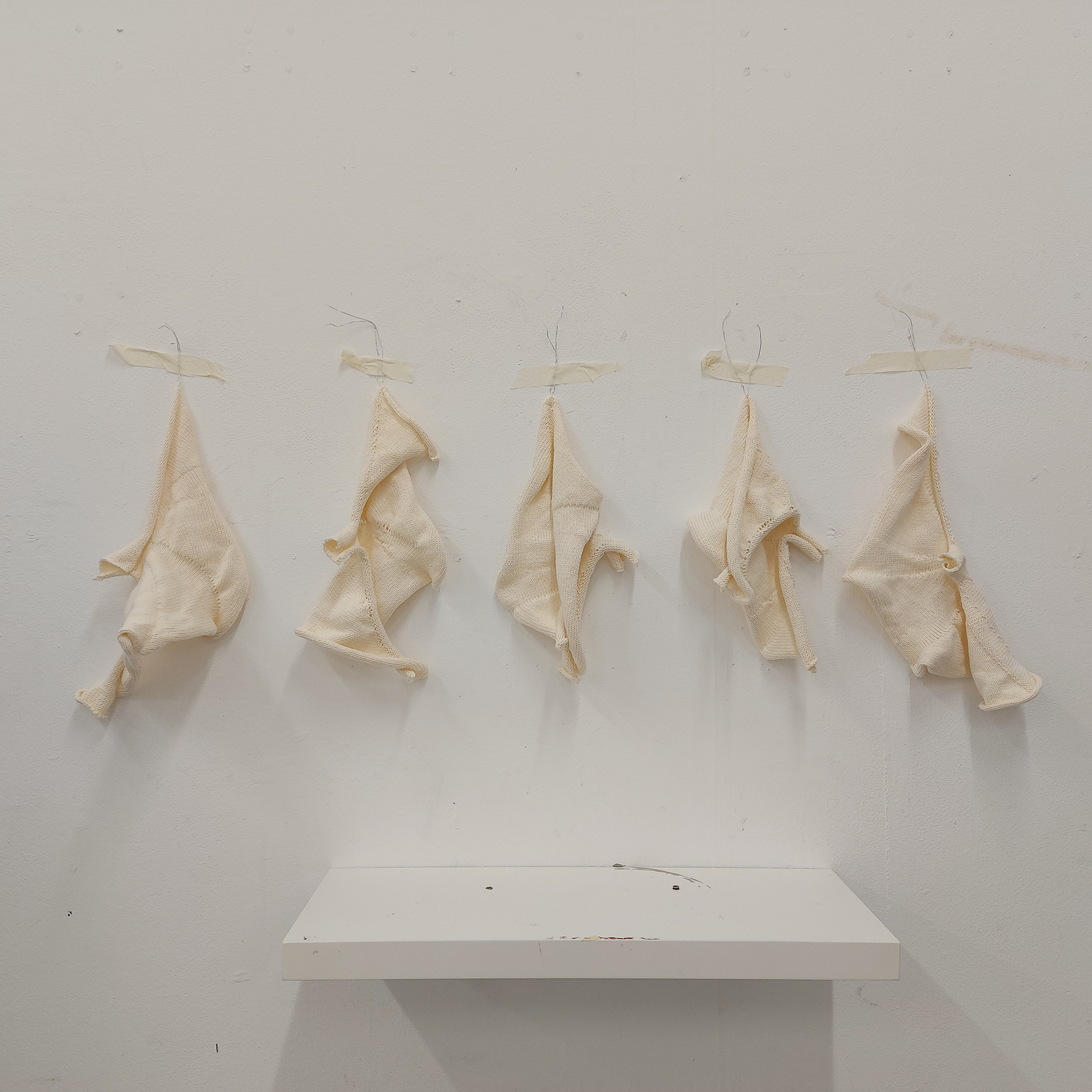

I learned how to create elongated stitches on the knitting machine, this is a way of hand knitting on the machine to create stitches that can become bigger or smaller dependent on the position of the stitches on the machine. Using this technique I thought about how using this technique could be used to respond to my environment and the different patterns these could make.
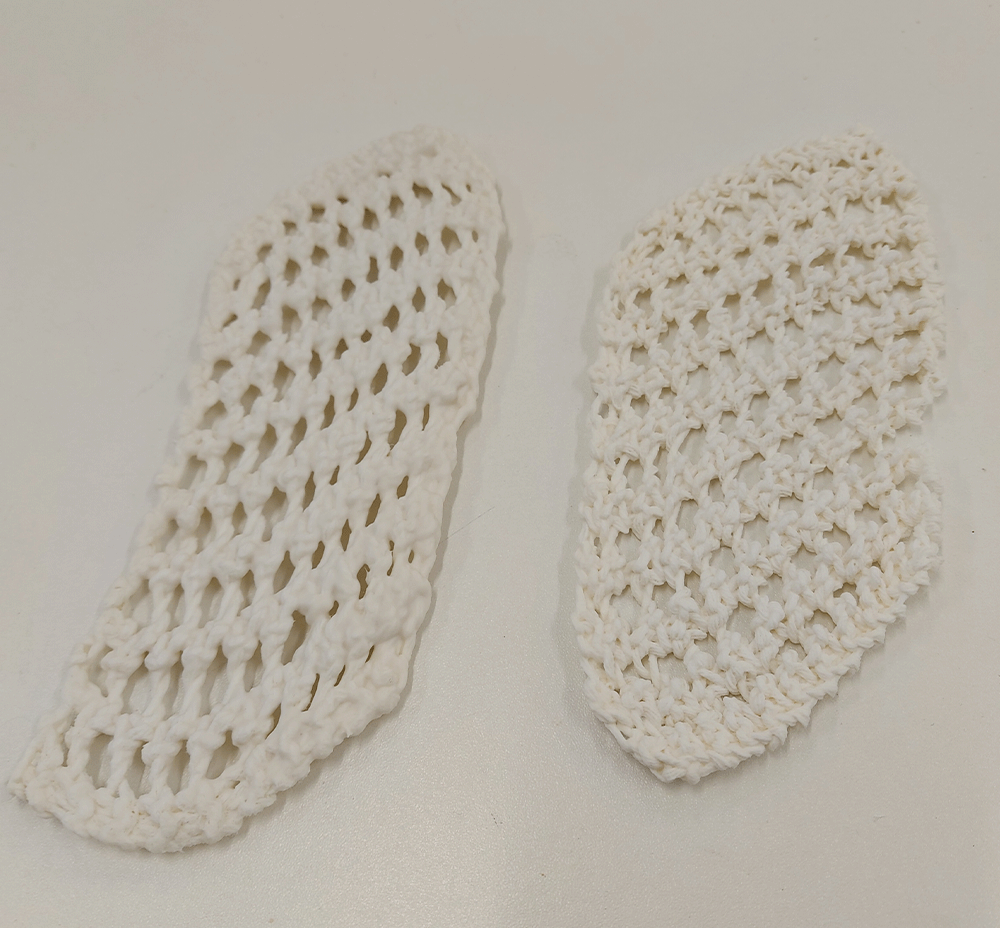
100% 80%
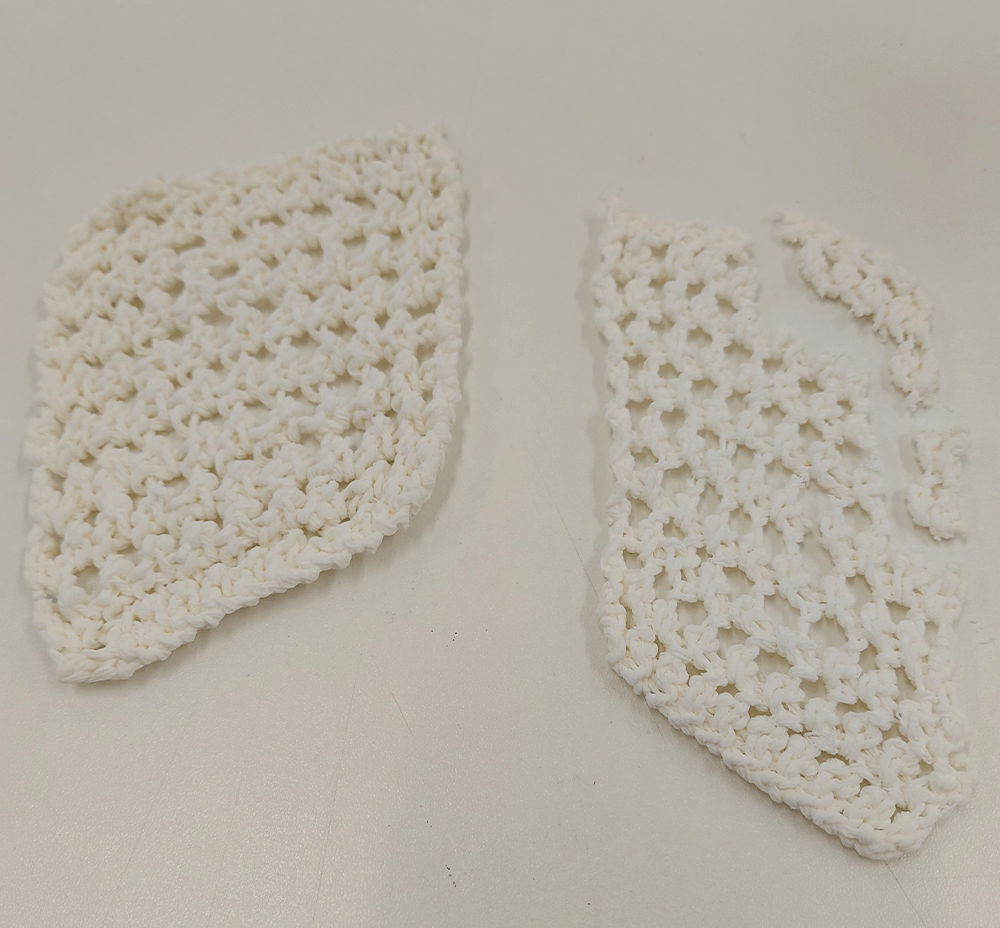
60% 40%
The slip experiments were fired to stoneware and came out of the kiln mostly intact, with the 40% slip sample coming out broken in 3 places. The 60% and 80% slip examples came out with a couple of small breaks but I would say the 80% slip would be the best go with and I would dip it in twice. The 60% slip sample broke more when I combined it with some knitted fabric (see below).
I found that when they both felt different in weight and this was shown by the sounds they made when putting them down on the same surface. The 40% slip sample was so light it felt like it was about to crumble in my fingers. I need my porcelain to be as strong as it can be as it will be interacting with knitted material.

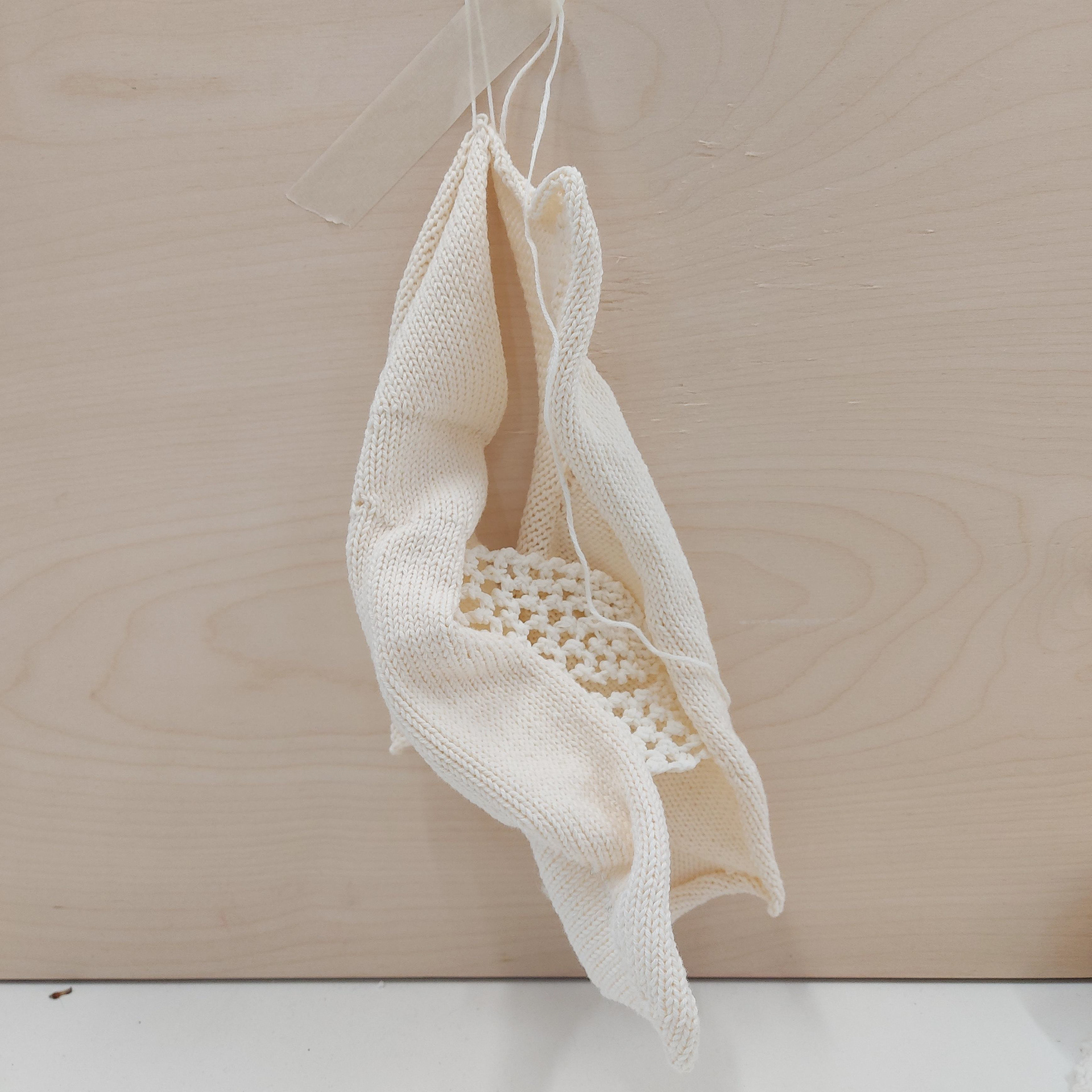
When experimenting with some machine knitted material and knitted porcelain that I had experimented with, I found that the knitted porcelain using 60% slip and 40% water had broken under the pressure of the knitting. I am finding that because the slip is so light, it's not really acting as a weight for the knitted material. One way that I could make the porcelain heavier is by layering the knitting or using cable which tend to make the knitting thicker due to the knitting overlapping over each other.
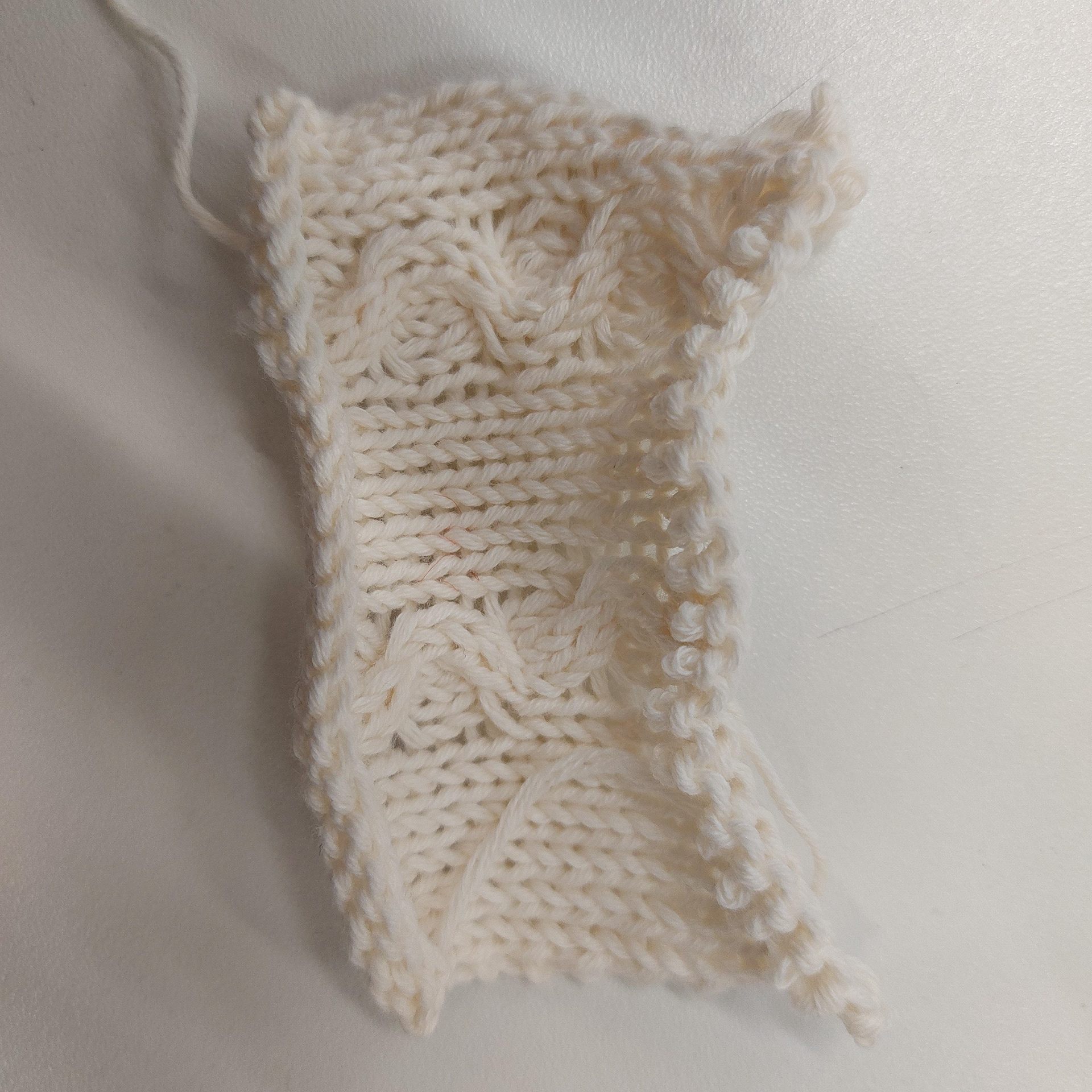
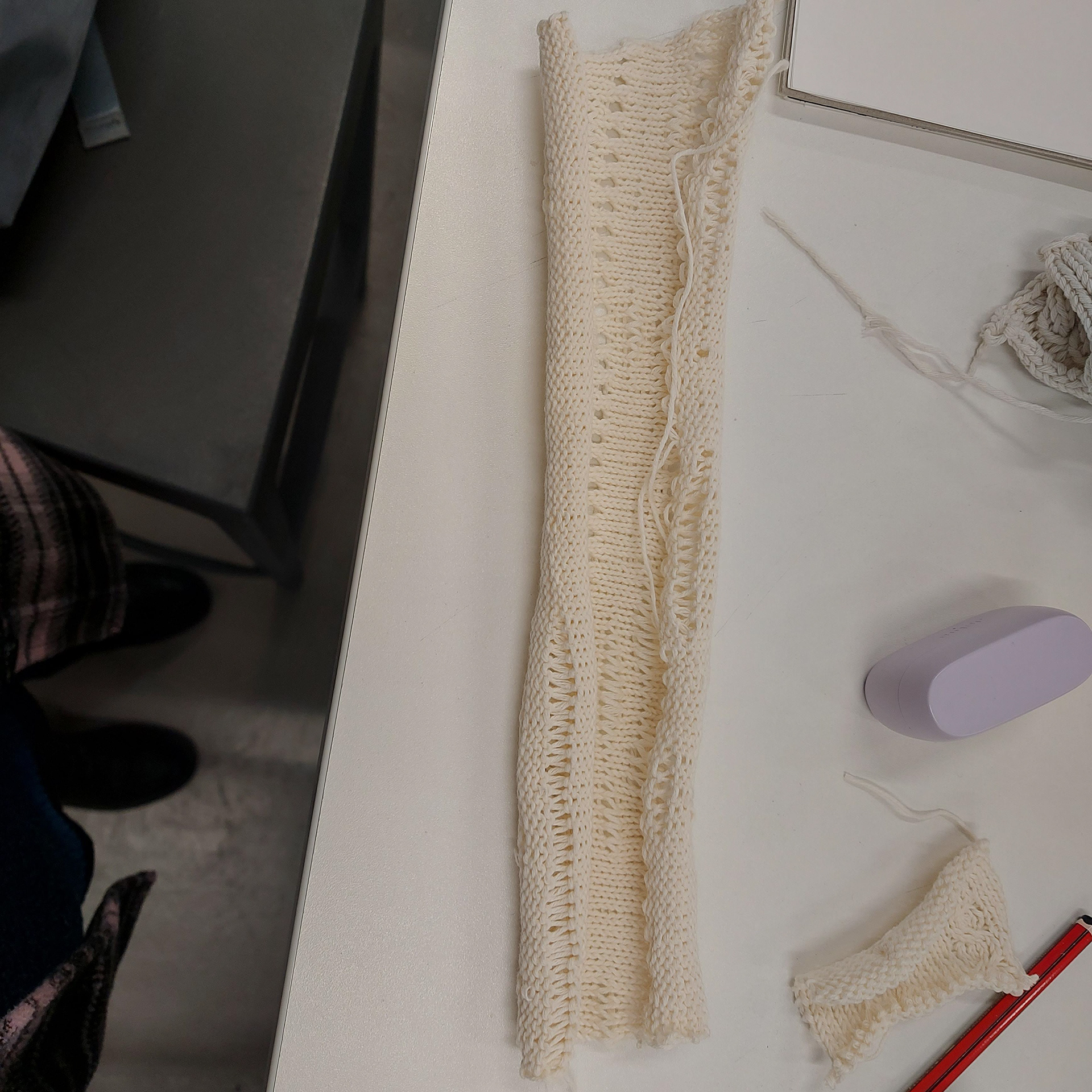
Above is some further experimentation on the knitting machine. I was able to make some cabled knitting on the machine which I could use in the future, however with the direction of partial knitting, the cables would not really work with partial knitting and did feel quite tense. When making a small sample using lace holes and elongated stitches, the piece rolled up quite significantly. I will need to take this into account within any final pieces. Steaming machine knitted work is a possibility, however, if I would like the work to sit naturally I will have to take this into account within my future work.

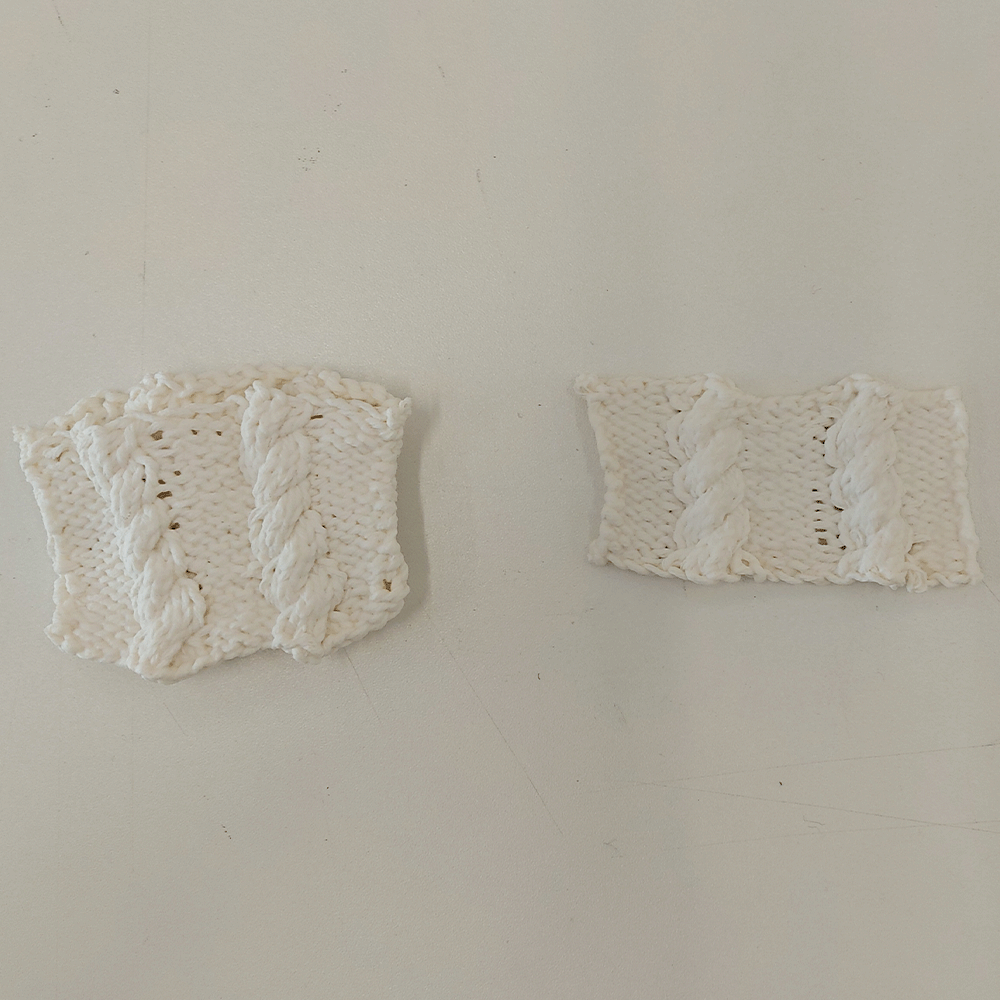
I layered cabled pieces on top of each other to see if the thicker work will work better as weights and will be heavier. These were very flat, however, I liked the cabled pattern and believed that this would work well for porcelain. The weight of the porcelain didn't weigh the knitting down as much as I needed it to, however, would be a good sample to use if I needed to test doubling up knitted sides for idea generation.